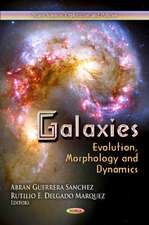Trends in Pulsar Research
Autor John A. Lowryen Limba Engleză Hardback – 30 noi 2006
Preț: 1300.62 lei
Preț vechi: 1783.28 lei
-27% Nou
Puncte Express: 1951
Preț estimativ în valută:
248.90€ • 258.28$ • 208.04£
248.90€ • 258.28$ • 208.04£
Carte disponibilă
Livrare economică 24 februarie-10 martie
Preluare comenzi: 021 569.72.76
Specificații
ISBN-13: 9781594545672
ISBN-10: 1594545677
Pagini: 211
Ilustrații: Illustrations
Dimensiuni: 183 x 261 x 18 mm
Greutate: 0.59 kg
Editura: Nova Science Publishers Inc
ISBN-10: 1594545677
Pagini: 211
Ilustrații: Illustrations
Dimensiuni: 183 x 261 x 18 mm
Greutate: 0.59 kg
Editura: Nova Science Publishers Inc
Cuprins
Preface; Pulsar Distances and the electron Distribution in the Galaxy; The Origin of the Magnetic Field of Pulsars and the Gravitomagnetic Theory; Accretion-Driven Millisecond X-ray Pulsars; A Link Between the Typical Radio Pulsars and Magnetars: Magnetic Eld Evolution Through Pulsar Glitches; Radiation of the Gravitational and Electromagnetic Binary; Neutrinospheres, Resonant Neutrino Oscillations, and Pulsar Kicks; Changes of the Orbital Periods of the Binary Pulsars; Quantum-Magnetic Collapse of a Neutron Gas: No Magnetar Fromation; Natal Pulsar Kicks from Back Reaction of Gravitational Waves; Index.

















